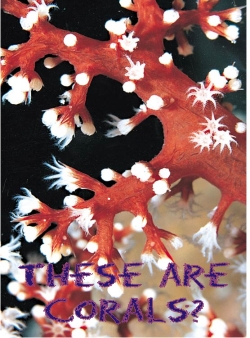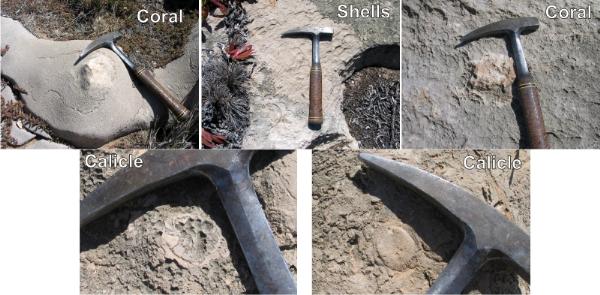
From the guidelines, as from January 2013"People do not need to wait for permission to log your EarthCache. Requiring someone to wait is not supported by the EarthCache guidelines. People should send their logging task answers to you, then log your EarthCache. When you review their logging task answers, if there is a problem, you should contact them to resolve it. If there is no problem, then their log simply stands."

We’ve all seen them on the National Geographic programs, we’ve all seen bits of them for sale in gem shops, we’ve seen them as adornment articles and we’ve certainly seen their picture in magazines. I refer to corals, those muticoloured, fragile “twigs and bobbles” we seen attached to the bottom of the ocean creating spectacular reefs.
Corals are marine organisms from the class Anthozoa and exist as small sea anemone–like polyps, typically in colonies of many identical individuals. The group includes the important reef builders that are found in tropical oceans, which secrete calcium carbonate to form a hard skeleton.
A coral "head", commonly perceived to be a single organism, is formed from thousands of individual but genetically identical polyps, each polyp only a few millimeters in diameter. Over thousands of generations, the polyps lay down a skeleton that is characteristic of their species. A head of coral grows by asexual reproduction of the individual polyps. Corals also breed sexually by spawning, with corals of the same species releasing gametes simultaneously over a period of one to several nights around a full moon.
A coral’s “head” appears to be a single organism although it is actually a head of many individual, yet genetically identical, polyps.
Polyps are usually a few millimeters in diameter, and are formed by a layer of outer epithelium and inner jellylike tissue known as the mesoglea. They are radially symmetrical with tentacles surrounding a central mouth, the only opening to the stomach or coelenteron, through which both food is ingested and waste expelled.
The stomach closes at the base of the polyp, where the epithelium produces an exoskeleton called the basal plate or calicle. This is formed by a thickened calciferous ring (annular thickening) with six supporting radial ridges.
The polyp grows by extension of vertical calices which are occasionally septated to form a new, higher, basal plate. Over many generations this extension forms the large calciferous (Calcium containing) structures of corals and ultimately coral reefs.
Formation of the calciferous exoskeleton involves deposition of the mineral aragonite by the polyps from calcium ions they acquire from seawater. The polyps are interconnected by a complex and well developed system of gastrovascular canals allowing significant sharing of nutrients and symbiotes.
At Praia da Cresmina, a remnants of corals are easily found associated with rocks that are Lower Cretaceous in age (145 – 65 Ma.). These limestones are fossilifeorus in many aspects and contain, corals (in several places you can still see the caclicles), orbiculina, shells and skeletal remains of dinosaurs.

The cache
The coordinates take you to an outcrop with a number of coral skeletal remains. You will recognize these by the white aragonite set against the more brown limestone (see above images). After observation of the outcrop tell me how many corals you can see. E-mail me the answers through my GC profile to validate your found.
NO tell-tale photos in the logs.
Have fun!
The help by fellow geologist, Prof. Paulo Fonseca (Faculty of Science of the University of Lisbon), is greatly appreciated in the creation of this cache..

Isto são corais?
Já todos os vimos nas páginas e programas da National Geographic, à venda aos pedaços em lojas de minerais e certamente já vimos imagens brilhantes destes organismos. No entanto, aquela imagem idílica que temos da sua beleza torna-se diferente quando os vemos preservados parcialmente nas rochas como fósseis.
 Corais ou recife de corais ou ainda antozoários são animais cnidários e uma das maravilhas do mundo submarino. Os corais constituem colônias coloridas e de formas espantosas que crescem nos mares e podem formar recifes de grandes dimensões que albergam um ecossistema com uma biodiversidade e produtividade extraordinárias.
Corais ou recife de corais ou ainda antozoários são animais cnidários e uma das maravilhas do mundo submarino. Os corais constituem colônias coloridas e de formas espantosas que crescem nos mares e podem formar recifes de grandes dimensões que albergam um ecossistema com uma biodiversidade e produtividade extraordinárias.
O maior recife de coral vivo encontra-se na Grande Barreira de Coral, na costa da Queensland, Austrália. Ele também é considerado o maior indivíduo vivo da Terra. Porém, devido à poluição e aquecimento marinho, está morrendo. A maioria dos corais desenvolve-se em águas tropicais e subtropicais, mas podem encontrar-se pequenas colónias de coral até em águas frias, como ao largo da Noruega.
Os corais são os membros da classe Anthozoa que constroem um "esqueleto" que pode ser de matéria orgânica ou de carbonato de cálcio. Os restantes membros desta classe que não formam exosqueleto são as anêmonas.
Quase todos os antozoários formam colónias, que podem chegar a tamanhos consideráveis – os recifes - mas existem muitas espécies em que os pólipos vivem solitários.
Os pólipos têm a forma de um saco (o celêntero) e uma coroa de tentáculos com cnidócitos (células urticantes) na abertura, que se chama arquêntero. Os antozoários não têm verdadeiros sistemas de órgãos: nem sistema digestivo nem sistema circulatório, nem sistema excretor, uma vez que todas as trocas de gases e fluidos se dão no celêntero, uma vez que a água entra e sai do corpo do animal através de correntes provocadas pelos tentáculos.
No entanto, esta classe de celenterados tem algumas particularidades na sua anatomia:
- Uma faringe, denominada neste grupo actinofaringe que liga a “boca” ao celêntero e que, muitas vezes, contem divertículos chamados sifonoglifos, com células flageladas, em posições diametralmente opostas, dando à anatomia do pólipo uma simetria bilateral.
- Os mesentérios - um conjunto de filamentos radiais que unem a faringe à parede do pólipo.
O grupo inclui os importantes construtores de recifes, conhecidos como corais hermatípicos, encontrados nos oceanos tropicais. Os últimos encontrados, são conhecidos como corais de pedra, visto que o tecido vivo cobre o esqueleto composto de carbonato de cálcio.
A cache:
Desta vez as coordenadas levam-te para o lado sul da Praia Cresmina onde se podem observar esqueletos fósseis de coral. Reconhecerás os corais pela cor esbranquiçada num fundo mais castanho dos calcários (vêr imagens acima). Para poderes logar esta cache quero que me digas quantos corais estão no afloramento.
Enviem-me uma mensagem com as devidas respostas para validar o found.
Nada de fotos reveladoras nos logs!
Agradece-se a amabilidade do geólogo Prof. Paulo Fonseca da Faculdade de Ciências da Universidade de Lisboa na criação desta earthcache..
Divirtam-se!
 The most exciting way to learn about the Earth and its processes is to get into the outdoors and experience it first-hand. Visiting an Earthcache is a great outdoor activity the whole family can enjoy. An Earthcache is a special place that people can visit to learn about a unique geoscience feature or aspect of our Earth. Earthcaches include a set of educational notes and the details about where to find the location (latitude and longitude). Visitors to Earthcaches can see how our planet has been shaped by geological processes, how we manage the resources and how scientists gather evidence to learn about the Earth. To find out more click HERE.
The most exciting way to learn about the Earth and its processes is to get into the outdoors and experience it first-hand. Visiting an Earthcache is a great outdoor activity the whole family can enjoy. An Earthcache is a special place that people can visit to learn about a unique geoscience feature or aspect of our Earth. Earthcaches include a set of educational notes and the details about where to find the location (latitude and longitude). Visitors to Earthcaches can see how our planet has been shaped by geological processes, how we manage the resources and how scientists gather evidence to learn about the Earth. To find out more click HERE.
______________________________________________________________________________
